Drawing With Circles and Squares
Drawing Basic Shapes
Many models kickoff with basic shapes. In SketchUp, the shape tools aid you draw rectangles, circles, and polygons. Yous find these tools on the Getting Started toolbar, the Drawing toolbar, and the Large Tool Gear up toolbar.
Table of Contents
- Drawing a rectangle or foursquare
- Drawing a rotated rectangle
- Drawing a circle or ellipse
- Drawing a polygon
- Editing shapes
Drawing a rectangle or square
In SketchUp, you can draw rectangles pretty much anywhere:
- On the footing airplane
- On a vertical aeroplane
- On existing faces
- Separate from existing geometry (aligned to an axes airplane)
- Inferenced from existing geometry
To draw a rectangle with the Rectangle tool, follow these steps:
- Select the Rectangle tool (
 ) from the toolbar or printing the R key. The cursor changes to a pencil with a rectangle.
) from the toolbar or printing the R key. The cursor changes to a pencil with a rectangle. Tip: To kickoff over at any point during these steps, printing Esc.
- Click to gear up the first corner point of the rectangle. .
- Click to ready the first corner signal of the rectangle. To align the plane of your rectangle with a specific drawing axis or other geometry, press the arrow key that corresponds your desired alignment, equally explained later in this department.
- Click to prepare the first corner bespeak of the rectangle. To align the plane of your rectangle with a specific cartoon axis or other geometry, press the pointer key that corresponds your desired alignment, as explained after in this section. If you prefer to draw the rectangle from the eye, press the Ctrl key (Windows) or the Option fundamental (macOS).
- Move the cursor diagonally to detect the desired size and shape for your rectangle. To draw the rectangle with precise dimensions, use the Measurements box, which at this signal displays your rectangle's dimensions equally you move the cursor. To help you lot identify the rectangle in relation to the cartoon axes or other geometry, SketchUp's inference engine displays on-screen cues. When the inference y'all need appears, motility to Step 4. Both the Measurements box and the Rectangle tool inferences are explained a little later in this section.
- Click again to gear up the 2nd corner point of the rectangle. Your shape appears with a face, as shown in the following figure.
- Click once again to prepare the 2d corner signal of the rectangle. Or if you're cartoon the rectangle from center, click again to set any corner point. Your shape appears with a face, as shown in the following figure.

As y'all draw a rectangle, the Measurements box helps y'all model precisely equally follows:
- Set the length and width. Type a length value, a comma, a width value, so printing Enter. For example, type 8',20' and press Enter. If you blazon simply a number or numbers, SketchUp uses the current document units setting. You lot tin besides override the document units setting by specifying royal (such as 1'6") or metric (such equally 3.652m) units.
- Specify only a length or width. If you enter a value and a comma (3',), the new value is practical to the first dimension, and the 2d dimension doesn't modify. Similarly, if you type a comma and and then a value (,3'), only the 2nd dimension changes.
- Change the rectangle's position with negative numbers. If you lot enter a negative value (–24, –24), SketchUp applies that value in a direction opposite to the one that you indicated while cartoon.
Tip: You don't demand to click in the Measurements box before you type a value. As you lot depict, the Measurements box is waiting for y'all to blazon precise measurements if you cull to do so. Also, until y'all select another tool or depict some other rectangle, you can utilize the Measurements box to change a rectangle's dimensions as many times as you lot like.
Notation: If y'all're using a not-English keyboard, employ a comma to indicate the decimal identify and a semi-colon to separate the dimensions. For example, you might enter ii sides of a rectangle equally: 7,6m;4,3m
Every bit yous move your cursor with the Rectangle tool selected, the SketchUp inference engine displays the following cues:
- Foursquare: When the rectangle's proportions are a perfect foursquare, you see blue dots and the Square ScreenTip announced. See Callout 1.
- Golden department: A gilt section is a rectangle in which the ratio of the longer side to the shorter side is a golden ratio. When a rectangle is a golden section, blue dots and the Golden Department Screen tip appear. Encounter Callout 2.
You lot tin hold downwards the Shift key to lock this inference while dragging.
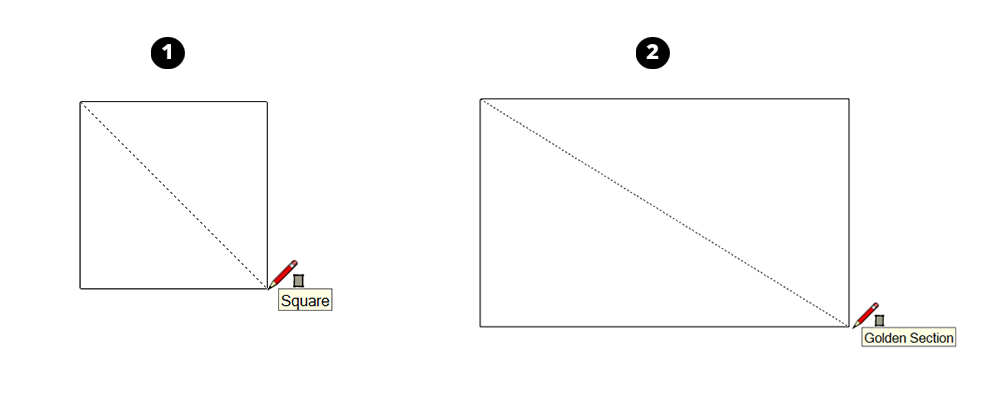
In the video, you lot can see these features of the Rectangle tool in activeness.
Cartoon a rotated rectangle
The Rotated Rectangle Tool tin come in handy when yous need to describe a rectangle whose face is at an angle to SketchUp's default red, green, or blue axes or to other geometry.
Like the Rectangle tool, the Rotated Rectangle tool enables you lot to create precise rectangles and squares and displays inferences to assistance yous as you lot draw. However, when you create a rectangle with the Rotated Rectangle tool, yous position the rectangle at an angle as well. The following figure is an example of a rectangle created with the Rotated Rectangle tool.
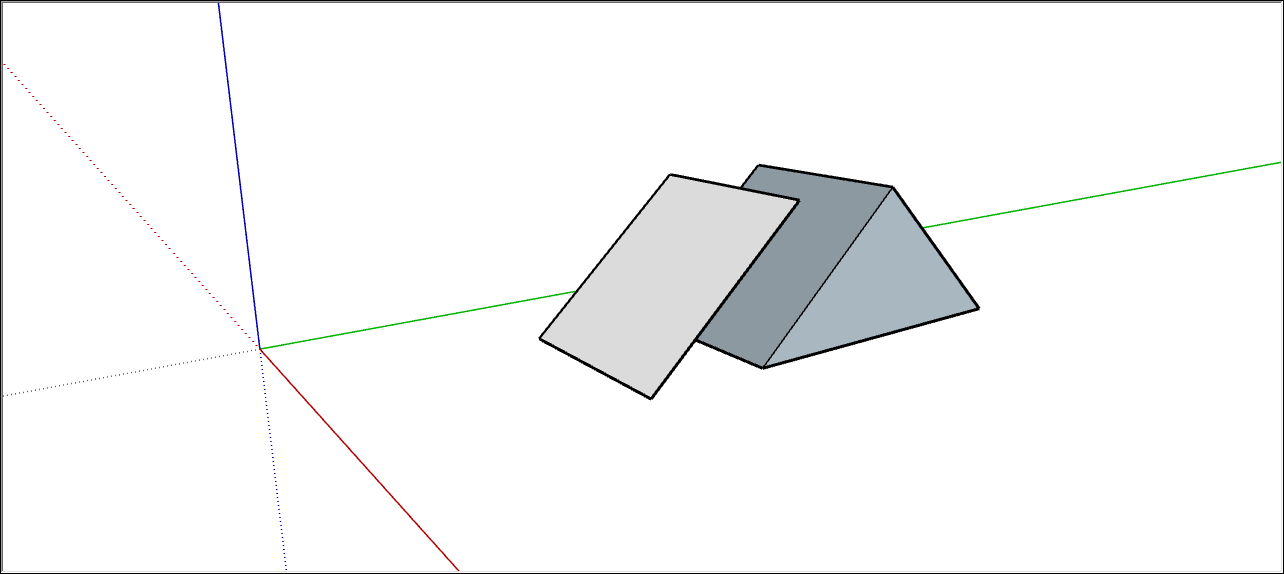
To create a rotated rectangle, follow these steps:
- On the toolbar, from the Shape Tools menu, select the Rotated Rectangle tool (
 ). Or select Draw > Shapes > Rotated Rectangle from the bill of fare bar.
). Or select Draw > Shapes > Rotated Rectangle from the bill of fare bar. - (Optional) Press an arrow fundamental to prepare the plane for your rotated rectangle, per the table that appears before in this commodity. For example, press the left arrow primal to constrain the plane of your rotated rectangle to the dark-green plane.
- Click one time to set the first corner of your rectangle.
- Create the beginning edge of your rotated rectangle. You can practice this in ii ways:
- Type a precise measurement and press Enter.
- Or move the cursor where yous desire to identify the second endpoint of this border, using the SketchUp inference engine to position the endpoint in relation to the axes or other geometry, as shown in the following figure, and then click.
Tip: You lot can use a few modifier keys every bit yous consummate this step. Hold downward the Shift key to constrain the start edge to its electric current direction. The Alt (Windows) or Command (macOS) key locks the protractor aeroplane. Or the pointer keys can again assistance you align the first edge to an axis. Simply press the pointer key that corresponds your desired alignment, as explained before in this section. For example, press the right arrow key to constrain the commencement edge then it's aligned with the blood-red axis.
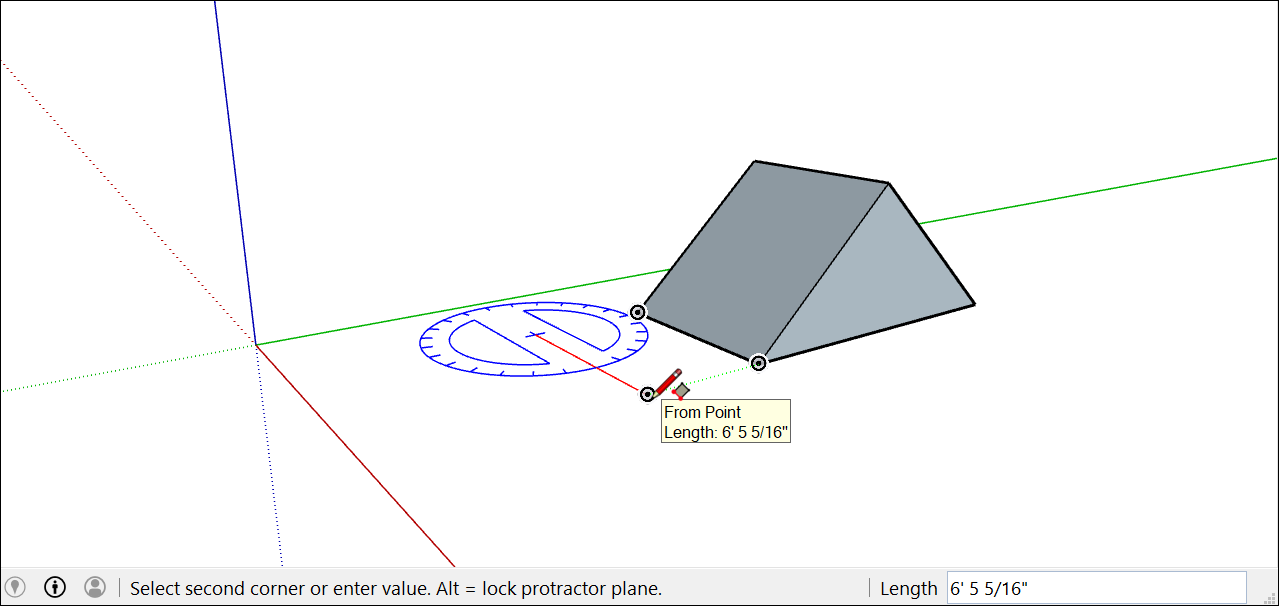
- At this point, y'all set the width and bending of your rectangle. Y'all can fix these values in a few different means:
- Blazon an angle and width into the Measurements box, post-obit the prompt.
- Type a width and angle into the Measurements box, following the prompt.
- Motility around the protractor to set the bending, and move your cursor away from the middle of the protractor to set the width, as shown in the following figure. To constrain the angle, hold down the Shift central. Click to terminate creating the rotated rectangle.
Tip: Printing the Alt (Windows) or Command (macOS) key to prepare the protractor baseline at the cursor'due south electric current position and so movement the cursor to mensurate the angle from the baseline y'all set up. This method is helpful if you lot want to mensurate the angle from a point other than the baseline ready in Step 3. A dashed line appears and then you can meet the new baseline.
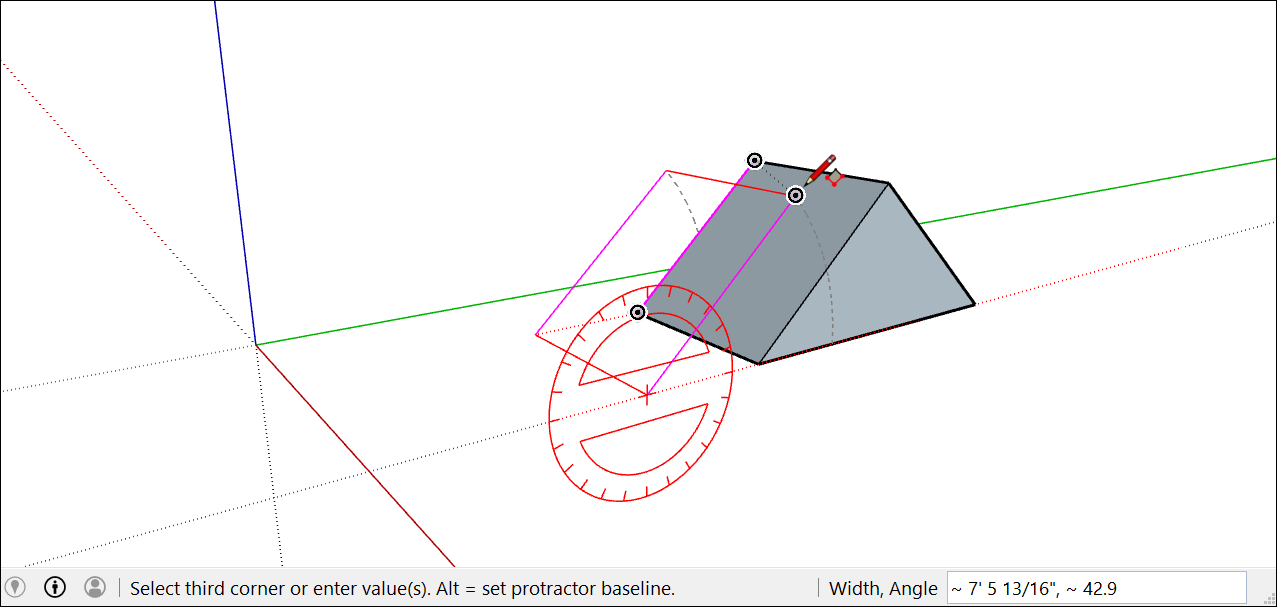
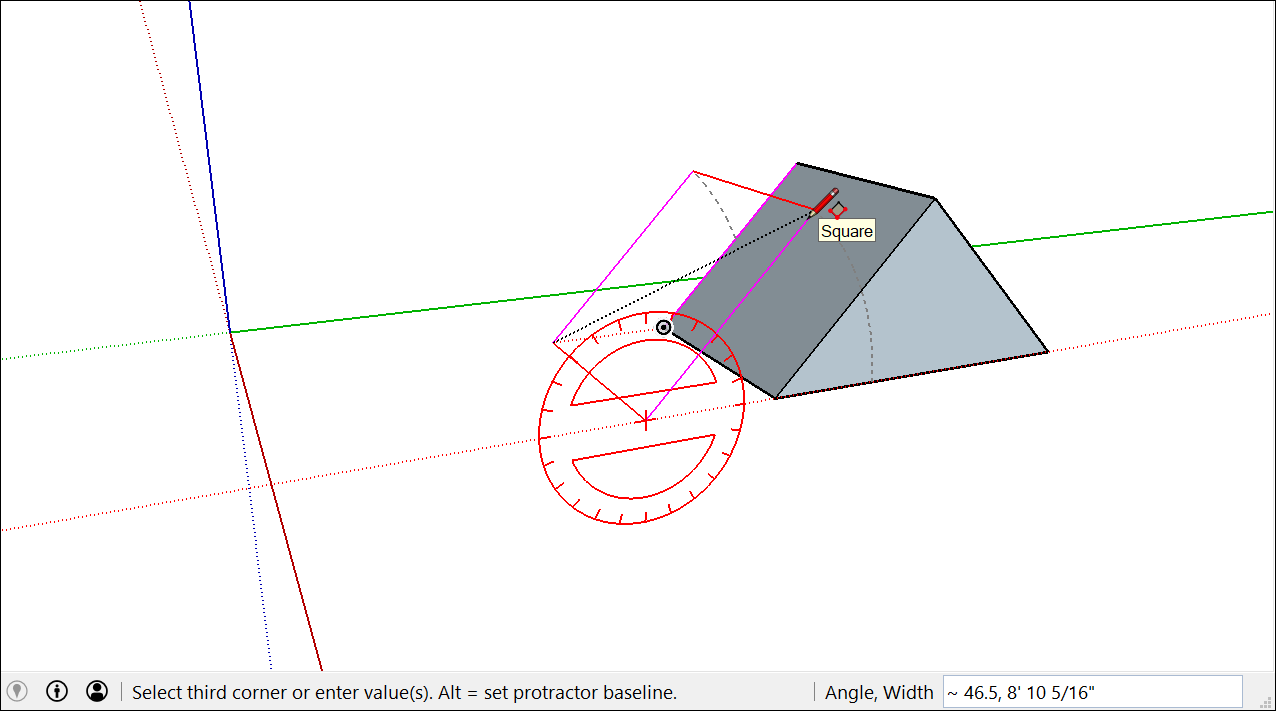
Note: if you're using a non-English keyboard, you'll want to use a comma to signal the decimal place and a semi-colon to divide the values in the Measurements box. For case, you might enter the angle and width of the second edge every bit 43,2;eight,2m to become an bending that's 43,2 degrees and 8,2 meters long.
Note: if y'all're using a not-English keyboard, you'll desire to use a comma to bespeak the decimal place and a semi-colon to separate the values in the Measurements box. For instance, yous might enter the width and angle of the second edge as eight,2m; 43,2 to get a width that'southward viii,2 meters long and angle that's 43,ii degrees .
Cartoon a circle or ellipse
Before you draw a circle, it's helpful to understand how SketchUp creates circle entities:
- Circle entities have a radius and connect multiple line segments.
- These segments act equally a single line in that they can define the edge of a face and carve up a face. Additionally, selecting 1 segment selects the entire circle entity.
- SketchUp's inference engine still sees the segments in the circumvolve. So, if you hover your mouse around the circumference of the circle entity, you'll run across endpoint and midpoint inferences.
To describe a circumvolve, follow these steps:
- On the toolbar, select the Circle tool (
 ) from the driblet-downwards carte du jour next to the Rectangle tool. Or printing the C key. The cursor changes to a pencil with a circle, and the Measurements box indicates the default number of sides: 24, as shown in the figure. To change the number of sides, you can type a value now or wait until later on you're done drawing the circumvolve.
) from the driblet-downwards carte du jour next to the Rectangle tool. Or printing the C key. The cursor changes to a pencil with a circle, and the Measurements box indicates the default number of sides: 24, as shown in the figure. To change the number of sides, you can type a value now or wait until later on you're done drawing the circumvolve. 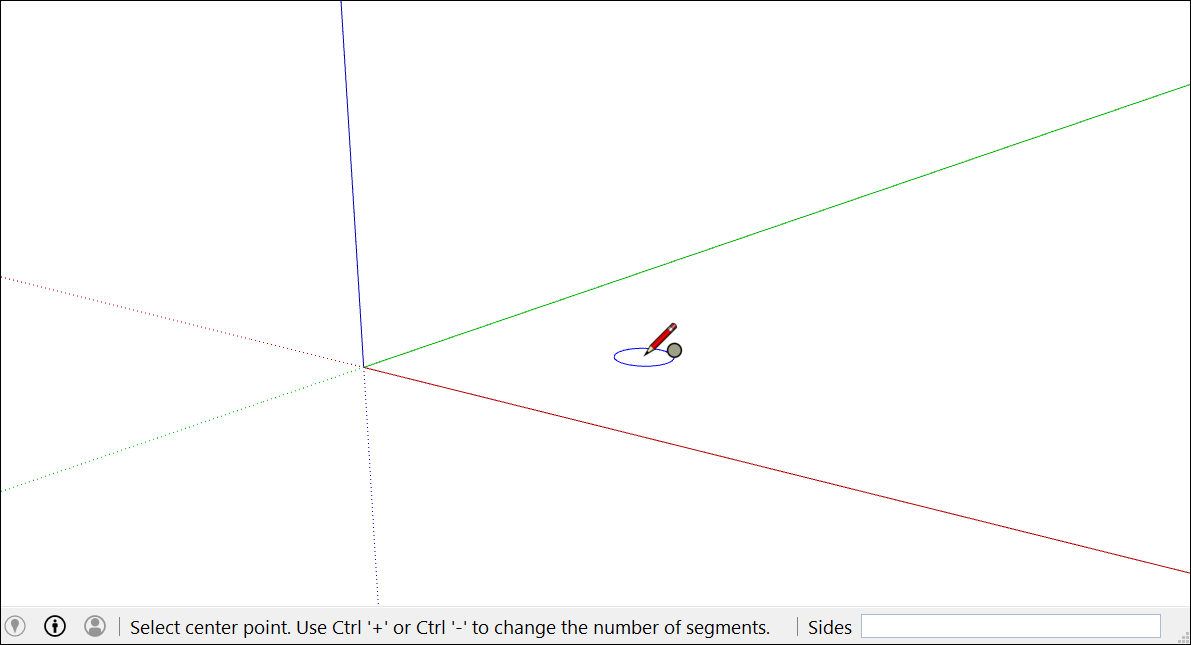
- Click to identify the center indicate of the circle. The Measurements box changes to display the circle's radius. You tin blazon a radius value now or immediately after you lot draw the circle.
- Click to place the center point of the circle. To align the plane of your circumvolve with a specific drawing axis or other geometry, press the arrow cardinal that corresponds your desired alignment. For example, the upward arrow aligns the circle's plane with the blueish centrality. See the table in Drawing a rectangle or square for details.The Measurements box changes to display the circle's radius. You tin type a radius value now or immediately subsequently you draw the circle.
- Move the cursor out from the center point to define the circle's radius. As you move the cursor, the radius value is displayed dynamically in the Measurements box. Press Esc at any signal to start over.
- Click to stop the circle. SketchUp creates a circle-shaped face, as shown in the figure.
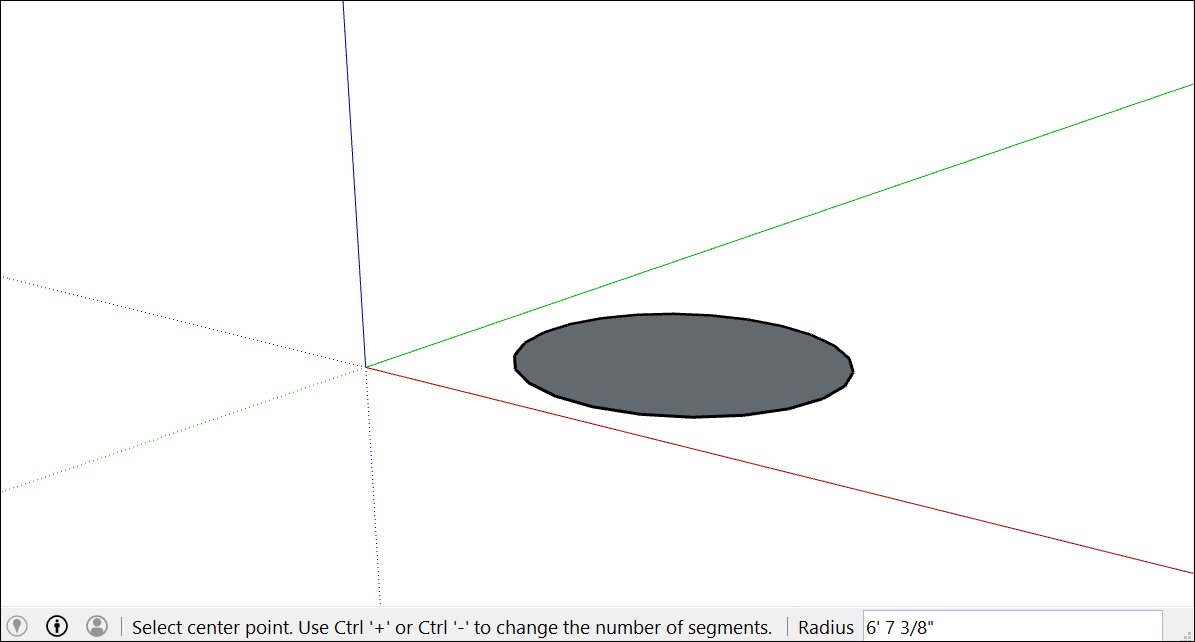
- (Optional) Until y'all select a new tool or depict a new circle, you lot can use the Measurements box to modify the circle's radius or the number of sides equally follows:
- To change the number of sides: Type a number and the letter S (for case, type 5s for five sides or 42s for 42 sides). Then press Enter.
- To change the number of sides: Type a number and the letter South (for example, type 5s for five sides or 42s for 42 sides). Then press Enter. Alternately, yous can hold down the Ctrl key (Microsoft Windows) or the Option key (macOS) while pressing the + or - to increase or subtract the number of sides, respectively. If you lot're using a French Canadian keyboard, hold downwards the Ctrl key (Microsoft Windows) and the +/= key to increment the segments. For macOS, printing Command and = to increase segments or - to subtract segments.
- To alter the radius: Type a number and a unit (if desired), such as half dozen", eight', 34cm, or 7m. So press Enter or Render.
Tip: The Entity Info dialog box offers a handy style to edit the sides and radius values anytime. Meet Editing shapes later on in this commodity for details.
To draw an ellipse or oval, follow these steps:
- Draw a circle with the Circle tool.
- Select the Scale tool (
 ).
). - Click the circumvolve. A bounding box with viii green grips is displayed around the circumvolve.
- Click one of the middle grips (non one of the corner grips) and move the mouse to pull the circle into an ellipse, as shown here.
- Click again when you're done scaling the circle.
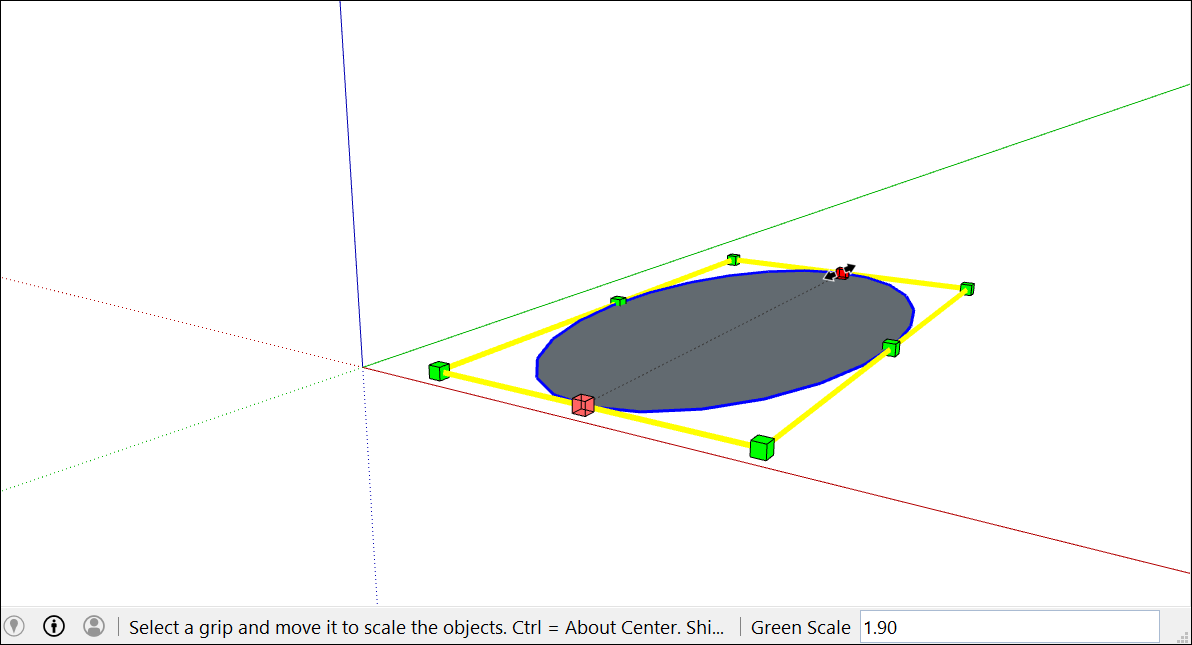
Drawing a polygon
You tin create polygon entities with the Polygon tool. (No surprise there.) Nonetheless, here are a few facts that you may non know nigh polygons, but that are handy to know every bit y'all describe them:
- In SketchUp, a polygon has a radius and three or more than sides. So the size of your polygon is measured from a center point, and the number of sides determines the type of polygon you describe. A pentagon equally five sides; an octagon has eight sides.
- Polygon entities act equally a single line in that they can define the border of a face and besides split a face up. Selecting i side of the polygon selects the entire polygon.
- The SketchUp inference engine interprets each side of a polygon as a segment. As you hover your cursor over a polygon, you lot meet endpoint, midpoint, and from signal inferences.
- You tin can draw polygons on faces or divide from existing geometry.
Follow these steps to depict a polygon:
- Select the Polygon tool (
 ) on the toolbar. The cursor changes to a pencil with a polygon. The Measurements box indicates the electric current number of sides. To modify the number of sides in your polygon, you lot tin can type a number value now or await until after you're washed cartoon.
) on the toolbar. The cursor changes to a pencil with a polygon. The Measurements box indicates the electric current number of sides. To modify the number of sides in your polygon, you lot tin can type a number value now or await until after you're washed cartoon. - Click to place the center point of the polygon. The Measurements box changes to display the radius. You lot can blazon a radius value now or immediately subsequently you draw the polygon.
- Click to identify the center point of the polygon. To align the aeroplane of your polygon with a specific drawing axis or other geometry, printing the arrow central that corresponds your desired alignment. For example, the up arrow marshal's the polygon'south plane with the bluish axis. Run across the earlier table in Drawing a rectangle or square for details.The Measurements box changes to display the radius. You can type a radius value now or immediately after yous depict the polygon.
- Movement the cursor out from the heart bespeak to define the radius of your polygon. Every bit yous move the cursor, the radius value is displayed dynamically in the Measurements box. To specify the radius, type a value and press Enter. You can likewise press Esc to start over.
- Click a 2nd time to finish the polygon. Here, yous see a v-sided polygon.
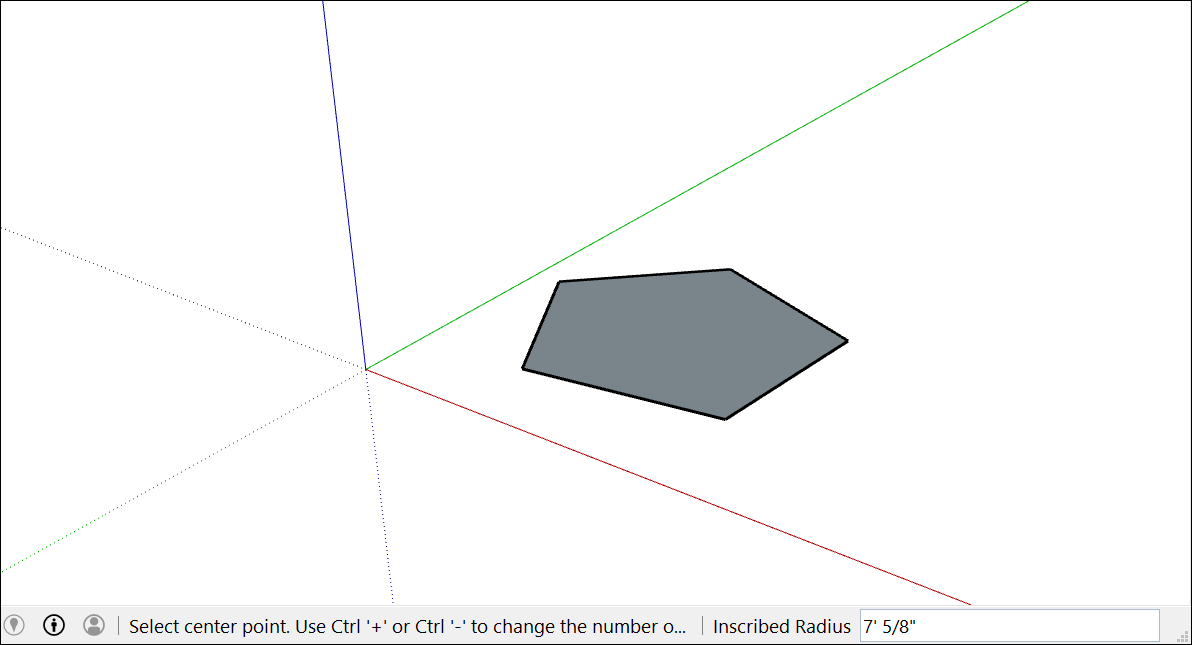
- (Optional) Until you lot select a new tool or draw a new polygon, you tin can use the Measurements box to change the radius or the number of sides as follows:
- To change the number of sides: Type a number and the letter of the alphabet South (for instance, blazon 5s for 5 sides or 42s for 42 sides). And then press Enter.
- To alter the number of sides: Blazon a number and the letter S (for example, type 5s for five sides or 42s for 42 sides). Then press Enter. Alternately, y'all can concur downwardly the Ctrl fundamental (Microsoft Windows) or the Option key (macOS) while pressing the + or - to increment or subtract the number of sides, respectively. If you're using a French Canadian keyboard, hold down the Ctrl key (Microsoft Windows) and the +/= key to increment the segments. For macOS, press Command and = to increase segments or - to decrease segments.
- To change the radius: Blazon a number and a unit (if desired), such as 6", eight', 34cm, or 7m. And so printing Enter or Return.
Tip: Although the Polygon tool works similarly to the Circle tool, the difference between the tools becomes apparent when you push/pull a circle or polygon into a 3D shape. The circle's edges look smooth, just a polygon's edges bear witness singled-out sides, every bit shown here.

In this live-action video, you can see the Circle and Polygon tools demonstrate all their stunts.
Editing shapes
The Entity Info dialog box enables you to change a circle or polygon's radius or sides anytime after you create the shape. Here'southward how:
- Context-click an edge (not the face) of a circle or polygon that you desire to edit.
- Select Entity Info from the context card that appears, every bit shown here.
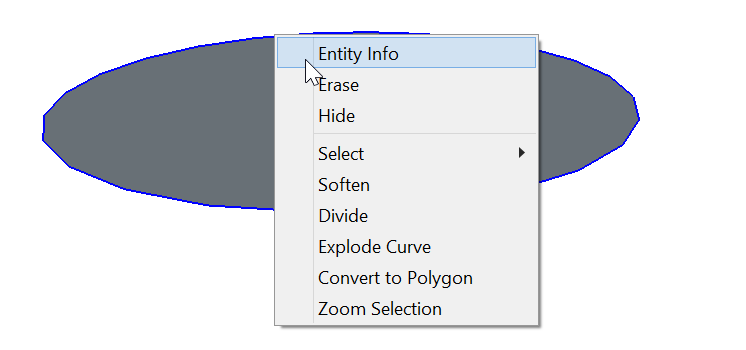
- In the Entity Info panel, click in the Radius or Segments box, change the value, and printing Enter (Microsoft Windows) or Render (Mac). Later y'all printing Enter or Return, your shape immediately reflects your changes.
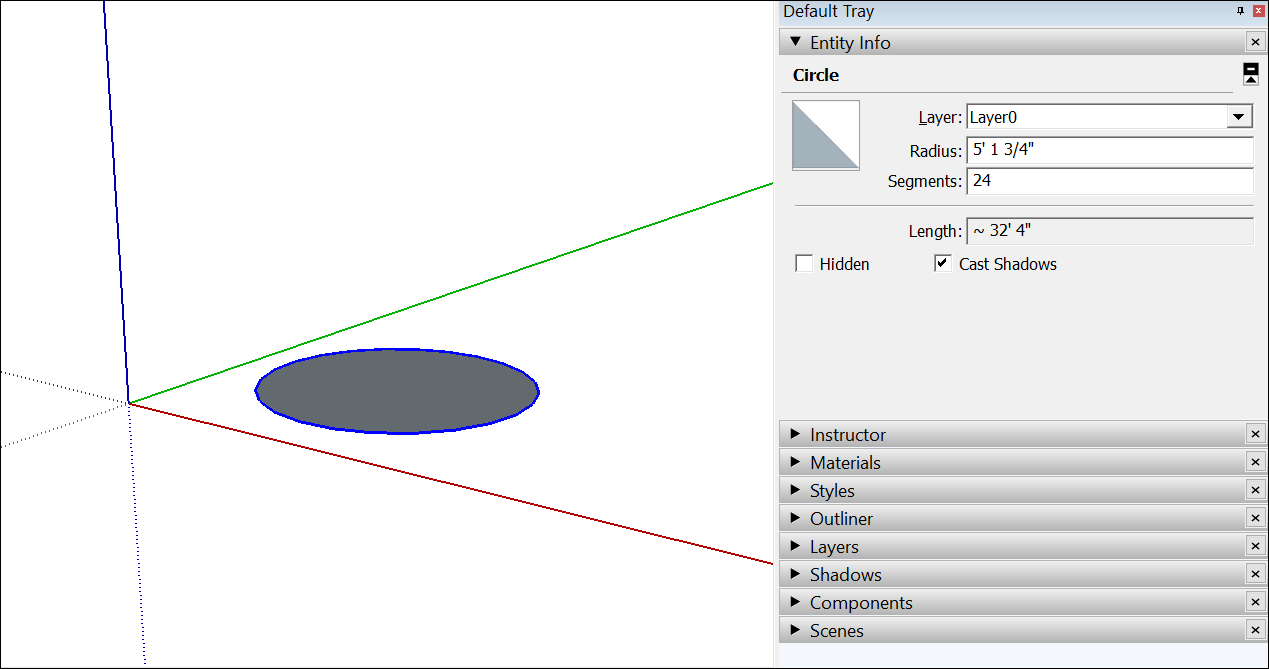
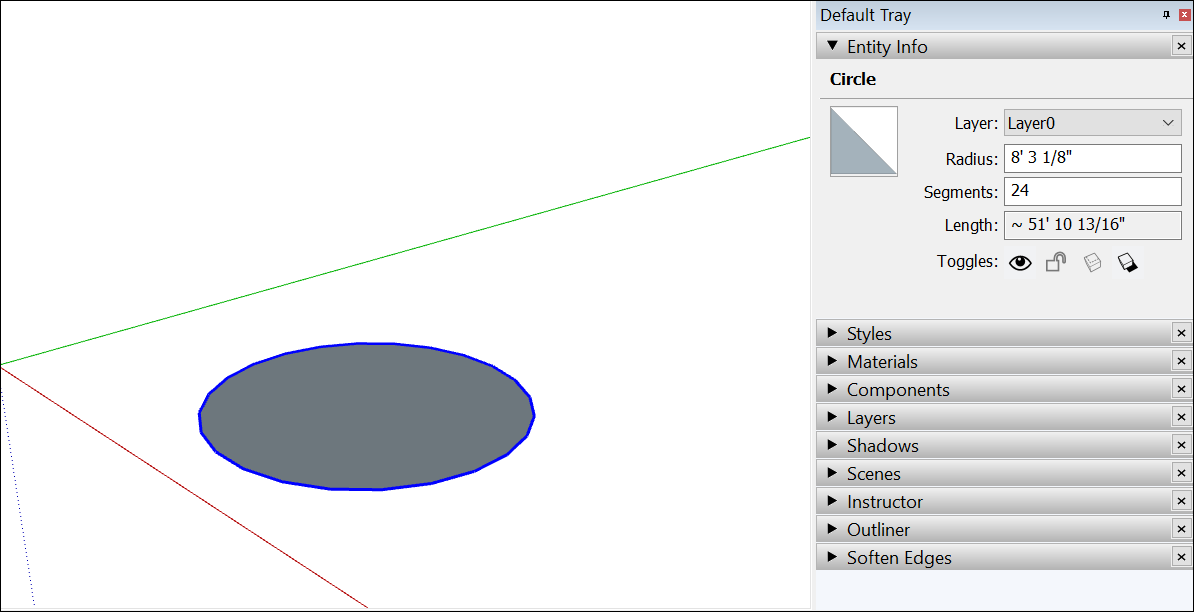
SketchUp doesn't enable you to change the width or length of a rectangle at anytime. If you've already selected some other tool or fatigued additional rectangles, you need to erase the rectangle you want to change and redraw it. See Drawing a rectangle for details. Or resize the rectangle with the Calibration tool if you don't need to enter precise dimensions.
Of course, you can do much more than simply change a shape's size. Y'all can plough a 2d shape into a 3D shape with the Push/Pull tool. You can misconstrue shapes with the Move tool or scale all or part of your model.
Source: https://help.sketchup.com/en/sketchup/drawing-basic-shapes
0 Response to "Drawing With Circles and Squares"
Post a Comment